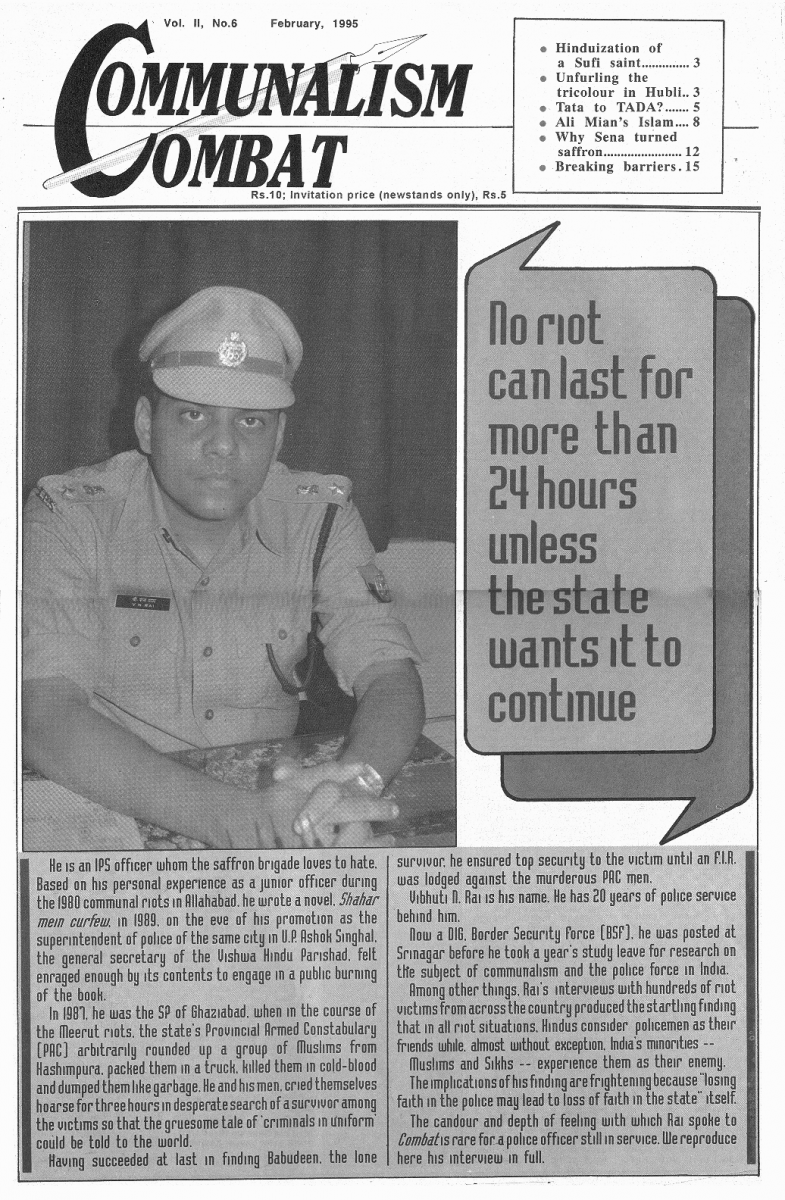.png)
Notwithstanding the positive role played by Communalism Combat in rehabilitating the "face of the Gujarat carnage" (Kutubuddin Ansari), notwithstanding the role played by the publication in producing and presenting Zahira Sheikh to the nation, notwithstanding the outstanding work the magazine performs in aiding and assisting those who have actually suffered in riots, Communalism Combat’s true function is to help win the information war that is being currently waged for the hearts and minds of Hindu India. It is this function which needs to be discussed and amplified because it is this war which, according to me, will determine the fate of secularism in our fragile republic.
I stress Hindus since it is they who will eventually decide which way the pendulum swings in the stand-off. For too long all of us who are on the side of the angels have been preaching to the converted. We urgently need to reach out to those who are confused, perplexed and bewildered by the high-decibel propaganda campaign being carried out in order to fundamentally alter the nature and ethos of Indian society. There are pessimists, of course, who believe the war is already lost, that India has been irredeemably and irrevocably communalised. The alarmists are wrong. The situation is dangerous but not hopeless. And they forget that finally secularism will triumph because secularism is the only device through which a political party or a coalition can rule a country as large, diverse and heterogeneous as India. Protection of secularism in India, therefore, is not a luxury but a pre-requisite for those with an eye on Delhi.
Information is the critical component in the aforementioned war. It can and will finally decide who wins and who loses. What we are seeing today is not just the distortion of reality, the truth is not merely being embellished or exaggerated, what we are witnessing is the systematic propagation of falsehood. Myths and prejudices are being paraded as facts and empirical data. Whether it is polygamy or conversions or demographics or madrassas, or the role of Indian Muslims in domestic and international terrorism, fact and fiction are freely mingled to conjure up a pre-arranged construct. If the facts don’t fit the case, start backwards – make the case fits the facts.
Communalism Combat has been performing a positive role as a corrective in presenting truth as it genuinely exists. And if I can be so presumptuous to offer gratuitous advice, this is the area where the publication needs to concentrate and use its admittedly limited resources to debunk myths and prejudices with verifiable and credible data. Armed with this data, truth can confront falsehood.
Take polygamy for instance. The received wisdom is that polygamy is practised largely among Muslims – the one-man-four-wives syndrome. Mr. Narendra Modi managed to convince most of Gujarat that this was an incontrovertible actuality in their state. However, the reality is markedly different. While a tiny, tiny minority of Muslims practise polygamy, it is the Hindus (from Dalits to rich Gujarati businessmen) who, in numerical terms, are the real "villains". The same species of misinformation prevails about birthrights among Muslims.
I am not unmindful of the role of the secular media. As the events in Gujarat showed, the random, unscripted aligning of press and TV to expose the real culprits was a powerful weapon in contradicting the version being put out by vested interests. If such a ghastly event were to occur again, I am certain the media would once again rise to the occasion and provide accurate and independent coverage. Sadly, the media has a notoriously short attention span, it seldom revisits a communal tragedy to re-check whether promises made for relief and rehabilitation have been honoured. Most crucially, numerous other news events loom enticingly on the horizon beckoning its attention.
It is only a publication like Communalism Combat, which has a completely different agenda and which, hopefully, does not rely on market forces for survival, that can single-mindedly and consistently focus on communalism and provide the editorial inputs — culled from a diverse variety of sources – to ensure that bigotry always gets a fitting reply in terms of facts and figures.
One of the problems a magazine like Communalism Combat faces is distribution. How do you reach it to the uncommitted – those sitting on the fence, the Don’t Knows, the undecided. I do not have a readymade answer to the problem but all of us fighting to preserve and strengthen secularism should put our heads together to see if we can help in any way. On the tenth anniversary of Communalism Combat there is no better gift we can give the magazine.
Archived from Communalism Combat, August-September 2003, Anniversary Issue (10th), Year 10, No. 90-91, Media 2

